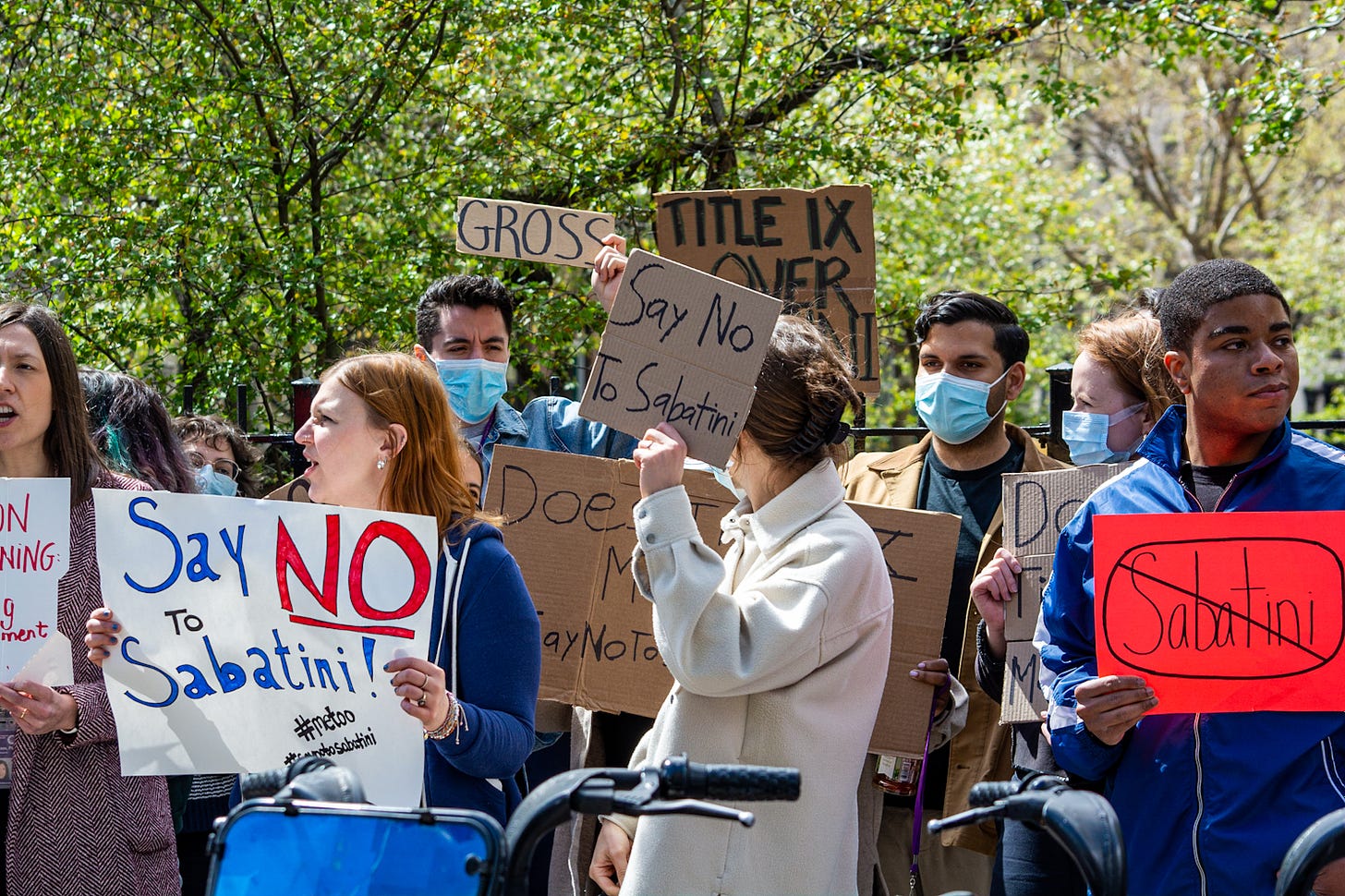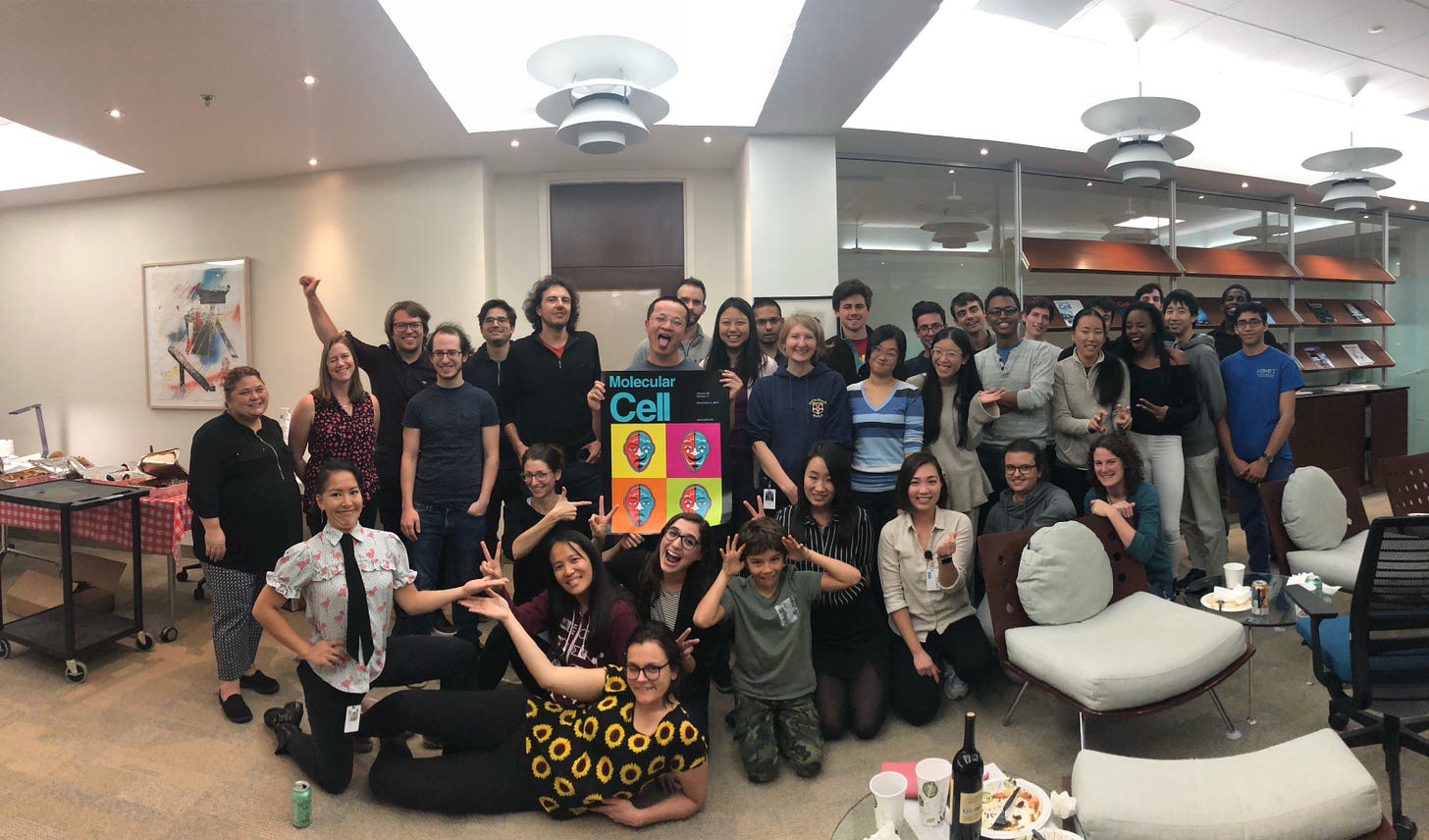In 2018, David Sabatini was a world-renowned molecular biologist. He was a tenured professor at MIT. He ran a major lab at the Whitehead Institute, overseeing a team of 39 researchers, postdocs and technicians. Their job was to disentangle the mystery of the mTOR signaling pathway, a protein Sabatini had discovered while still in medical school, at Johns Hopkins. The mTOR signaling pathway plays a critical role in tumor development. Figuring out how it works would go a long way toward saving countless lives.
This was why Sabatini was predicted to win the Nobel Prize. It was how he reeled in between three and four million dollars every year for his lab from the National Institutes of Health, the Pentagon and the Howard Hughes Medical Institute, among others. It is why his colleagues have described him to me with words like “genius,” “one of the best scientists alive,” and “a pillar.”
“It’s like working for Steve Jobs. He can be brutal,” said one scientist. “But why would you want to work for anyone else?”
Today, Sabatini is unemployed and unemployable. No one wants to be associated with him. Those who do risk losing their jobs, publishing opportunities, friends, visas, and huge federal grants. “What wormhole did my life take, to billionaires and protests and being called a sexual predator? What quirk in the universe allowed this to happen?” Sabatini asked me.
The entrance to the wormhole can be found in Rockville, Maryland, at a hotel that Sabatini was staying at while attending a conference about lysosomes and cancer sponsored by the National Institutes of Health. There, on the night of April 18, 2018, after an evening of whiskey tasting—Sabatini is a whiskey aficionado—he and Kristin Knouse had sex. Knouse was an incoming cancer researcher at the Whitehead, where she would also head her own lab; hers focused on liver regeneration. He was 50. She was 29. He had split with his wife, and was in the process of getting a divorce.
The next month they met up at Knouse’s condo near Boston Common where they discussed a few ground rules for their tryst. They agreed they could see other people. Knouse, Sabatini remembers, had ongoing flings with men who she referred to with nicknames like “anesthesiologist fuck buddy,” “finance bro,” and “physics professor,” and she wanted to keep it that way. Also, they wouldn’t tell anyone. Why complicate things at work? It was all supposed to be fun.
But then, in August 2018, the Whitehead adopted a new Consensual Sexual and Romantic Relationships Policy, which stated that lab heads couldn’t have a “consensual or sexual relationship” with any coworkers. “Not going to H.R. right then was my critical mistake,” Sabatini told me.
At the time, Sabatini didn’t think it mattered much. Things were fizzling. He still cared for Knouse, and they were still close—he had a cancer scare in late 2018, and when he found out he wasn’t dying, she was one of the few people he texted. But he was getting involved with another woman, a microbiologist in Germany.
Knouse didn’t want to let go. In January 2020 she texted, in part: “I get anxious when I don’t hear back from you and then I see you post stuff on Twitter and it provides an admittedly small and silly but still another bit of evidence to this growing feeling that you don't care about me in the way that I care about you.” He wrote back: “I am sorry but you are being crazy.” In another text, Knouse admitted feeling “stung.” She added: “I think it’s worth thinking about whether you want someone who matches your passion, intellect, and ambition.” He wrote back: “I have to explore this.” (Knouse declined to talk with me. This account is based on interviews with Sabatini, more than a dozen colleagues of both Sabatini and Knouse, legal filings, text messages, emails, and documents obtained exclusively by Common Sense.)
For a few months, Knouse broke off communication with him. Then Covid hit. In April 2020, she reached out via text. She made a dorky joke about the pandemic and enemas. They griped about Covid safety protocols. She invited him and his son to her family’s beach house on Cape Cod for some “low density private beach and pool action.” She bought a new red Audi and sent him a picture of it. Her grandmother died, and he told her he was sorry for her loss, and they went back and forth about her traveling to Pennsylvania for the funeral. “A big hug,” he texted her, “and a safe travels!”
Then, in late summer or early fall—when the whole country was gripped by protests and riots, and everyone was apologizing and reckoning—something changed.
In October 2020, Knouse texted her friends that she was “unpack[ing] a ton of suppressed abuse and trauma from an obvious local source”—an apparent reference to Sabatini. Knouse’s fellowship at the Whitehead was ending, and she didn’t apply for any faculty jobs there. When the new director, Ruth Lehmann, called Knouse to ask why, Knouse complained for the first time of being “harassed.”
In November, Knouse warned her friend—an incoming Whitehead fellow—to “squeeze out as much advice as possible before your mentor is Weinstein’ed out of science.”
In December, at Lehmann’s behest, the consulting firm Jones Diversity sent the Whitehead employees a survey “based in part on Dr. Knouse’s false complaint about Dr. Sabatini,” according to a complaint later brought by Sabatini. All participants were anonymous. Five or so of the nearly 40 employees in Sabatini’s lab took part.
The next month, two former Sabatini lab members lodged complaints to H.R.—the first complaints against him in his 24-year tenure—about “bro culture” in the lab.
This prompted the Whitehead to hire the law firm Hinckley, Allen & Snyder to conduct an investigation on “gender bias and/or inequities and a retaliatory leadership in the Sabatini lab.” The Whitehead never told Sabatini what he was accused of. Former lab members told me their co-workers were sobbing when they came out of meetings with the lawyers, saying that the lawyers had put words in their mouths. “They had a very strong agenda,” one of them told me.
In retrospect, it was already over for this once-in-a-generation scientist.
On January 19, 2020, Knouse texted Sabatini: “The only certainty in your life, now and forever, is that you love your son and your lab more than anything else. Be careful not to abandon them despite your current mental state. Take care.”
A little more than a year-and-a-half later, on August 13, 2021, the lawyers finished their 248-page report.
A few days after that, Sabatini was at home when he got the email with the Whitehead report attached to it. Soon after, an invitation for a short meeting with Lehmann appeared on his calendar. She had never bothered to meet one-on-one with the most famous person on her payroll, and he suspected what was up. He called his lawyers immediately, and they confirmed that he was about to be fired.
In the 24 hours after the report came out, Sabatini’s life fell apart. MIT put him on administrative leave. The Howard Hughes Medical Institute, another prestigious non-profit that funds biomedical research and was paying Sabatini’s salary, fired him. He resigned from the Whitehead, and eventually MIT, at the advice of his lawyers who thought it would help him secure his next job. (“I one hundred percent regret that,” Sabatini told me).
Soon, the biotech startups he’d helped found— Navitor Pharmaceuticals, KSQ and Raze Therapeutics—started severing their relationships with him. Sabatini was axed from professorships, fellowships, and professional societies. Awards and grants were pulled. His income disappeared.
On August 20, Lehmann officially cut ties with Sabatini in an email sent to the whole institute. That was leaked to the Boston Globe within minutes; the news was circulating on Twitter within hours.
“I lost everything. My whole life imploded,” Sabatini said. “I became a shell of what I was.”
Sabatini stopped sleeping at home so he didn’t have to hear the FedEx envelopes plopping down on his doormat—invariably another letter from another institution cutting ties with him. He toggled between his brother’s home—Bernardo Sabatini, a professor of neurobiology, runs his own lab at Harvard Medical School—and his ex-wife’s. He stopped eating and sleeping. He went on unemployment and dropped 35 pounds in three months. He cried a lot, and his hair was falling out. A friend of Sabatini told me he sent Sabatini articles about mTOR to keep him preoccupied, and sleeping pills to help him crash at night. Nothing worked.
Another friend, a fellow scientist, explained: “I love my science, but I also have other interests. David isn’t like that. Science is his one and only.”
So what exactly had those 248 pages said? What had David Sabatini been found guilty of that merited this kind of punishment? Chiefly, failing to disclose his consensual relationship with Knouse. On top of that, the report found that Sabatini, in his day-to-day administration of the lab, violated the Whitehead’s Anti-Harassment Policy, since his “behavior created a sexualized undercurrent in the lab.” Sabatini’s relationship with Knouse exacerbated things, given his “indirect influence” over her, which violated the Anti-Harassment Policy and ran afoul of the “spirit” if not the letter of another of the institute's policies.
True, he didn’t supervise Knouse. He didn’t work directly with her. He never threatened her or proposed a quid pro quo. And he certainly didn’t have the power to fire her. But, according to the report, he had “experience, stature, and age” over her. Knouse’s apparent desire to continue their relationship only served to confirm his influence: “That she felt the need to act ‘fun’ to impress Sabatini underscores how Sabatini’s words and actions profoundly impacted her,” the lawyers wrote.
Nor did the lawyers care for the happy hours and whiskey tastings that Sabatini sometimes hosted in his office, which betrayed his “apparent ‘friendliness’ and general propensity to have ‘fun.’” (Knouse, in her counterclaim, says the events were “drunken,” and “conversations quite frequently veered to the sexual.”)
“While we have not found any evidence that Sabatini discriminates against or fails to support females in his lab, we find that Sabatini’s propensity to praise or gravitate toward those in the lab that mirror his desired personality traits, scientific success, or view of ‘science above all else,’ creates additional obstacles for female lab members,” the report concluded.
This was baffling to everyone I spoke to: Nine of Sabatini’s current and former lab employees, a current faculty member at the Whitehead, and half a dozen top doctors and scientists in Sabatini’s field. Most of them would not speak on the record for fear of being associated with Sabatini and derailing their own careers. “It’s impossible to be honest about this and preserve your own skin,” says a scientist who recently worked under Sabatini.
That trainee called the report’s depiction of the lab an “alternate reality,” and the characterization of Sabatini as lascivious and retaliatory “deeply insane.”
“They have the wrong guy,” a female scientist who knows Sabatini and Knouse told me. A female former trainee told me that the climate in Sabatini’s lab was “one of excellence.” She said that Sabatini could be demanding, but he was never demeaning or unfair. “I try to emulate him in my own lab,” another female former trainee said. A third female trainee said the lab could be informal, but it was hardly a locker room. “It just wasn’t in the air.“
I asked a former technician about the notorious whiskey tastings. “These weren’t keggers,” he said. “‘Bench scientists’ and ‘party’ don’t generally overlap.”
The allegations over the relationship and the ones about the lab’s culture served to reinforce each other; if Sabatini was so ill-advised as to hook up with a younger colleague, surely his bad judgment spilt over into his (extremely well-funded) lab. Making such a claim also appeared to be advantageous to the Whitehead.
For one, it would allow Lehmann to be seen as a no-nonsense leader with zero tolerance for the sexism in science that she saw as a challenge. It would also pacify Knouse, who wanted to see Sabatini fired publicly. “Part of me just wants to organize a protest outside of Whitehead and this would be over in a matter of hours not weeks,” wrote Knouse to a friend during the investigation.
Then, there’s the money.
Until recently, the NIH deterred institutions from firing or even investigating scientists who brought in a lot of NIH money, because that money usually followed the scientists—not the institutions. So for years, universities and other research organizations often turned a blind eye to their superstars’ bad behavior for fear of losing multi-million-dollar grants. To correct this, the NIH amended its policy in June 2020. Moving forward, if principal investigators are accused of “harassment, bullying, retaliation, or hostile working conditions” recipient institutions are obligated to alert the NIH, who would use the information to decide whether or not to reassign the grant. The NIH hoped to end the game of “pass the harasser.”
The Whitehead’s arrangement with NIH is especially lucrative: On top of all the grant money it brings in, the institute also gets a nearly 95 percent “facilities and administrative” or F&A fee, as insiders put it. (Usually, NIH pays organizations 25 to 50 percent.) Every $500,000 Sabatini reeled in was actually worth closer to $1 million to the Whitehead. “Once they decided a priori to fire him, that kind of dictated how the investigation needed to be done in order to keep any NIH money,” said a former trainee. “It would be a perfect kill shot. By doing it the way they did it, they guaranteed he couldn’t be hired, and where’s he going to take the grants if he can’t be hired?”
At least a few of Sabatini’s grants were transferred to Jonathan Weissman, who is currently listed as the principal investigator on “Novel Components of the mTORC1 and mTORC2 Pathways,” and “Cell Growth Signaling in Cancer Development,” and “Regulation of the mTOR Pathway by Nutrients” worth $487,500 and $463,125, and $416,813 respectively.
In October 2021, Sabatini filed a lawsuit against Knouse, Lehmann, and the Whitehead. He claimed that Knouse had “fabricated claims” that he had sexually harassed her, and that the Whitehead’s investigation was a sham. A few weeks later, Knouse filed a counterclaim that accused Sabatini, among other things, of sexual “grooming.”
I spoke with Ellen Zucker, Knouse’s attorney, for nearly an hour, but she insisted on not saying anything on the record. Knouse declined to comment. So did Lehmann, the Whitehead’s director.
At a meeting after Sabatini’s case was filed, on November 3, 2021 Lehmann, Kay Hodge, the Whitehead’s attorney, and the head of HR informed those left in the lab that NIH rules barred those who had worked under Sabatini from having any contact with him at all. When some of them objected—Sabatini, at that point, was just a guy living in Boston—a scientist who was there recalled Hodge warning them: “You wouldn’t want to jeopardize your future eligibility for NIH funding.” There was a chill in the room. “That’s a death sentence,” the scientist said.
The whole thing was baffling to those who know Sabatini. “It’s as if the best player in the NFL got cut because he said something politically incorrect on social media,” Peter Attia, a medical expert on longevity and a close friend of Sabatini, told me. “In my opinion, he’s one of the top five scientists of his generation in my area,” said Ben Neel, who runs NYU’s cancer center. I asked a former trainee what she made of Sabatini’s reputation. “You don’t have to ask me, just look at his PubMed,” she said, referring to his copious list of published findings.
In late 2021, six months after he resigned, Dafna Bar-Sagi, the Vice Dean of Science at NYU Langone Health, which comprises New York University’s medical school and several hospitals, called Sabatini. He was an old friend. She knew about everything that had happened, and she wanted to check in on him. He lamented that no one would ever hire him again. Bar-Sagi said he was being silly. Of course, she said, someone somewhere would give him a job. He was the famous David Sabatini. Finally, he asked her point blank, Would she?

On a bright, breezy Wednesday morning in late April on the corner of 30th Street and First Avenue, in the shadow of the huge, glass buildings that make up part of NYU Langone Health, the protesters were chanting, “Whose school? Our school!” and someone was screaming, “Safety!” They were angry, incredulous—many of the postdocs and researchers and faculty were waving posters that said things like, “WTF NYU” and “No to Sabatini!” They could not believe that this was going to happen.
They hadn’t read the lawyers’ report, but they had read the internet, and they didn’t like what they’d read. NYU was about to hire a “serial sexual harasser,” as one of the demonstrators put it, trading grant dollars for their trainees’ “safety.” So where should a superstar researcher do his research? Where does the guy who’s going to help cure cancer go? “Uhhh, Prison?” Madeleine Sutherland, a postdoc, told me.
The demonstration was sparked by an article in Science magazine that reported that NYU higher-ups and Sabatini had been in talks for several months. Nothing was set in stone. There was no formal offer on the table.
“The work was exhaustive to vet Sabatini,” Ken Langone, the billionaire philanthropist and chair of the Board of Trustees of the NYU Langone Medical Center tells me. “If there was anything untoward about this man’s behavior, we would not have touched him with a ten foot pole.”
“David is one of the greatest scientists of our century,” Bar-Sagi told me. Hoping to clear the way for Sabatini, and wary of not appearing insensitive to the Whitehead report’s findings, NYU was conducting its own investigation—“at the risk,” Bar-Sagi said, “of depriving society of the benefit of having someone like this continuing their career and making really meaningful discoveries that can affect human health for generations.”
NYU shared the Whitehead report with several outside lawyers, who all concluded that Sabatini was not afforded due process.
But the internal pressure, the bad press, and the tweets from within and without NYU were becoming too much. Postdocs at the medical school were threatening to retract papers. Faculty had been ostracized for not publicly blasting Sabatini. Andrew Hamilton, NYU’s president, sent a letter “strongly advising” that the medical school not go through with hiring Sabatini. “Faculty at the University and elsewhere have been told not to work with us. And also, speakers are being told not to come here,” an NYU administrator texted a colleague.
On May 3, NYU announced: “After careful and thorough consideration that included the perspectives of many stakeholders, both Dr. David Sabatini and NYU Grossman School of Medicine have reached the conclusion that it will not be possible for him to become a member of our faculty.”
“If people are close minded to the idea that there can be a consensual relationship between two adults, I’m afraid we can’t make any traction,” said Grossman, the dean of NYU Medical School. Neel, who would’ve become the second most famous cancer researcher at NYU had Sabatini been hired, tells me, “I find it all deeply disappointing and frightening.”
As if all this weren’t enough, the NIH started making noise. They’d gotten several anonymous complaints about Bar-Sagi. She has never had any complaint about her in her entire career. Her apparent crime appears to have been initiating the conversation with Sabatini.
Last week, NIH officials sent NYU a letter questioning Bar-Sagi’s ability to provide a safe environment for trainees. “It’s a pretty interesting message,” said Grossman. NIH also informed the university that it was auditing Bar-Sagi’s involvement in over $500 million in grant money that it had awarded to NYU. Most of that, $470 million, is for a study on long Covid.
Sabatini told me has a recurring nightmare: He’s trapped in the Whitehead building when he discovers he’s not allowed to be there. He frantically tries to get to an exit, but he never makes it out. In real life, he has no idea what became of his lab, or the millions of dollars of equipment and reagents there, or the half-finished experiments including projects on neurodegeneration and ovarian cancer. Most everyone has left.
Sabatini spends his days shuffling around, watching Netflix, caring for his 11-year-old son and taking calls from lawyers. He got some job offers, from China, Russia, and the United Arab Emirates—places that don’t care about the things he’s accused of. Knouse is now an assistant professor of biology at MIT, and she runs her own lab at the Koch Institute for Integrative Cancer Research, named after the late MIT alum and conservative mega-donor David H. Koch following a $100 million gift.
One wonders whether the very rich people shoveling piles of money into these institutions have any idea about what’s going on within them.
At the protest, I met Tulsi Patel, a postdoc at Columbia. Patel tells me about a new bullying policy at Columbia, which she helped to write, to deal with “power-based harassment” that doesn’t fall into the already illegal categories like sex and race-based harassment. “We recommended calling it the Office of Conflict Resolution, just to make it sound like a chill thing, like it’s about resolving conflicts,” Patel said. The provost is reviewing the proposal.
Grossman, the dean of NYU’s medical school, talks a lot about, “listening to our community” and “believing in the process,” but the protestors don’t really care about any of that. They’re playing a different game. They know that if they make enough noise, if they claim enough “harm,” NYU— or any other school that brands itself as inclusive or progressive—will give in. And even if Sabatini were hired, no one would have worked with him. It would have been social suicide to.
Many of the researchers and postdocs I spoke to pointed out that, as scientists, it’s essential to look carefully at all the evidence and to leave no stone unturned. The way the Whitehead and MIT conducted their investigation into David Sabatini runs counter, they say, to the scientific method itself. It also sends a clear message: That ground-breaking research takes a backseat to an ideal of social purity, and that subjective truth is the only truth that matters.
“In my lab, there were two criteria we always strived toward; that the discovery is fundamentally true, which means proving it in many different ways, and that it’s new,” Sabatini said. “Everyone talks about your truth, and my truth. Physically, chemically, there’s only one truth.”











our Comments
Use common sense here: disagree, debate, but don't be a .